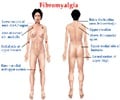Patients with fibromyalgia often suffer from unexplained pain and scientists suggest that it could be due to a mismatch between sensory and motor systems.
Patients with fibromyalgia often suffer from unexplained pain and scientists suggest that it could be due to a mismatch between sensory and motor systems.
In a study published in the journal Rheumatology, researchers asked patients to look at a reflection of one arm whilst moving their other in a different direction, which was hidden behind the mirror.This created a mismatch between what the brain sees via sensory input and what it feels through the motor system that controls movement.
Of the 29 patients involved in the study, 26 reported feeling a transient increase in pain, temperature change or heaviness in their hidden limb - all symptoms of a ‘flare up’ of their condition.
This suggests that a mismatch between sensory and motor neurons could be at the root of the fibromyalgia – a condition affecting one in 100 people in the UK at some stage of their lives.
“The chronic pain experienced by people with fibromyalgia is hard to understand because there are no obvious clinical signs that pain should be experienced,” said Dr Candy McCabe, one of the researchers involved in the University of Bath and Royal National Hospital for Rheumatic Diseases study.
“We have shown that by confusing the motor and sensory systems we can exacerbate the symptoms felt by people diagnosed with the condition.
“We have had some success to date in using a similar technique to help alleviate the symptoms of this kind of chronic pain.
Volunteers in the study were asked to perform a series of bilateral upper and lower limb movements with a mirror in front of them at a right angle.
This meant that one limb was obscured from view behind the mirror whilst they could clearly see the other limb and its reflection.
They first carried out the same movements with both limbs, and then made different movements.
This enabled the researchers to see what effect confusing what the brain could see with what it could feel.
“Nearly all of the group reported an increase in the sensations connected with their condition in the hidden limb,” said Dr McCabe, who works in the University's School for Health.
“This provides strong evidence that sensory-motor conflict is at the heart of this condition.
“Some clinicians do not recognise fibromyalgia as a diagnosis because of a lack of clinical reason for the pain.
“It is often considered to be a reflection of anxiety or attention seeking behaviour which, for people with the condition, can be very hard to deal with.
“Nevertheless, fibromyalgia is one of the most common conditions seen by rheumatologists.
“Hopefully we are beginning to understand more about the condition, and taking steps towards how it might be treated in the future.”
People with fibromyalgia complain of widespread pain, multiple tender points, stiffness, sleep disturbance and fatigue.
Around nine out of ten of those affected by fibromyalgia are women. In most cases it develops between the ages of 30 and 60, but it can develop in people of any age, including children and the elderly.
There are around 14,700 new cases in the UK each year.
Source-Eurekalert
GAN/C
 MEDINDIA
MEDINDIA
 Email
Email










